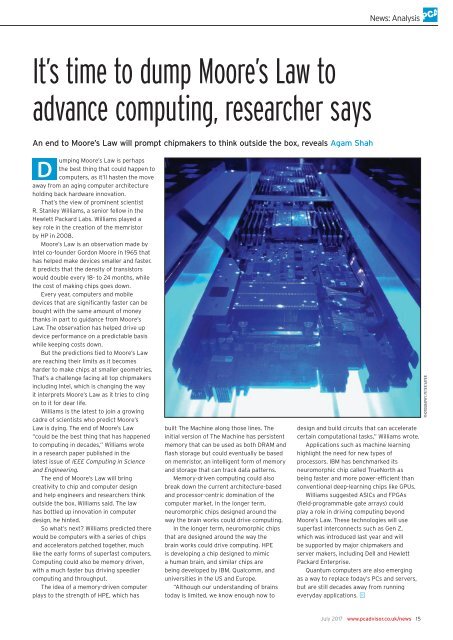You also want an ePaper? Increase the reach of your titles
YUMPU automatically turns print PDFs into web optimized ePapers that Google loves.
News: Analysis<br />
It’s time to dump Moore’s Law to<br />
advance computing, researcher says<br />
An end to Moore’s Law will prompt chipmakers to think outside the box, reveals Agam Shah<br />
D<br />
umping Moore’s Law is perhaps<br />
the best thing that could happen to<br />
computers, as it’ll hasten the move<br />
away from an aging computer architecture<br />
holding back hardware innovation.<br />
That’s the view of prominent scientist<br />
R. Stanley Williams, a senior fellow in the<br />
Hewlett Packard Labs. Williams played a<br />
key role in the creation of the memristor<br />
by HP in 2008.<br />
Moore’s Law is an observation made by<br />
Intel co-founder Gordon Moore in 1965 that<br />
has helped make devices smaller and faster.<br />
It predicts that the density of transistors<br />
would double every 18- to 24 months, while<br />
the cost of making chips goes down.<br />
Every year, computers and mobile<br />
devices that are significantly faster can be<br />
bought with the same amount of money<br />
thanks in part to guidance from Moore’s<br />
Law. The observation has helped drive up<br />
device performance on a predictable basis<br />
while keeping costs down.<br />
But the predictions tied to Moore’s Law<br />
are reaching their limits as it becomes<br />
harder to make chips at smaller geometries.<br />
That’s a challenge facing all top chipmakers<br />
including Intel, which is changing the way<br />
it interprets Moore’s Law as it tries to cling<br />
on to it for dear life.<br />
Williams is the latest to join a growing<br />
cadre of scientists who predict Moore’s<br />
Law is dying. The end of Moore’s Law<br />
“could be the best thing that has happened<br />
to computing in decades,” Williams wrote<br />
in a research paper published in the<br />
latest issue of IEEE Computing in Science<br />
and Engineering.<br />
The end of Moore’s Law will bring<br />
creativity to chip and computer design<br />
and help engineers and researchers think<br />
outside the box, Williams said. The law<br />
has bottled up innovation in computer<br />
design, he hinted.<br />
So what’s next? Williams predicted there<br />
would be computers with a series of chips<br />
and accelerators patched together, much<br />
like the early forms of superfast computers.<br />
Computing could also be memory driven,<br />
with a much faster bus driving speedier<br />
computing and throughput.<br />
The idea of a memory-driven computer<br />
plays to the strength of HPE, which has<br />
built The Machine along those lines. The<br />
initial version of The Machine has persistent<br />
memory that can be used as both DRAM and<br />
flash storage but could eventually be based<br />
on memristor, an intelligent form of memory<br />
and storage that can track data patterns.<br />
Memory-driven computing could also<br />
break down the current architecture-based<br />
and processor-centric domination of the<br />
computer market. In the longer term,<br />
neuromorphic chips designed around the<br />
way the brain works could drive computing.<br />
In the longer term, neuromorphic chips<br />
that are designed around the way the<br />
brain works could drive computing. HPE<br />
is developing a chip designed to mimic<br />
a human brain, and similar chips are<br />
being developed by IBM, Qualcomm, and<br />
universities in the US and Europe.<br />
“Although our understanding of brains<br />
today is limited, we know enough now to<br />
design and build circuits that can accelerate<br />
certain computational tasks,” Williams wrote.<br />
Applications such as machine learning<br />
highlight the need for new types of<br />
processors. IBM has benchmarked its<br />
neuromorphic chip called TrueNorth as<br />
being faster and more power-efficient than<br />
conventional deep-learning chips like GPUs.<br />
Williams suggested ASICs and FPGAs<br />
(field-programmable gate arrays) could<br />
play a role in driving computing beyond<br />
Moore’s Law. These technologies will use<br />
superfast interconnects such as Gen Z,<br />
which was introduced last year and will<br />
be supported by major chipmakers and<br />
server makers, including Dell and Hewlett<br />
Packard Enterprise.<br />
Quantum computers are also emerging<br />
as a way to replace today’s <strong>PC</strong>s and servers,<br />
but are still decades away from running<br />
everyday applications. J<br />
PhotograPhy: Peter sayer<br />
<strong>July</strong> <strong>2017</strong> www.pcadvisor.co.uk/news 15


















